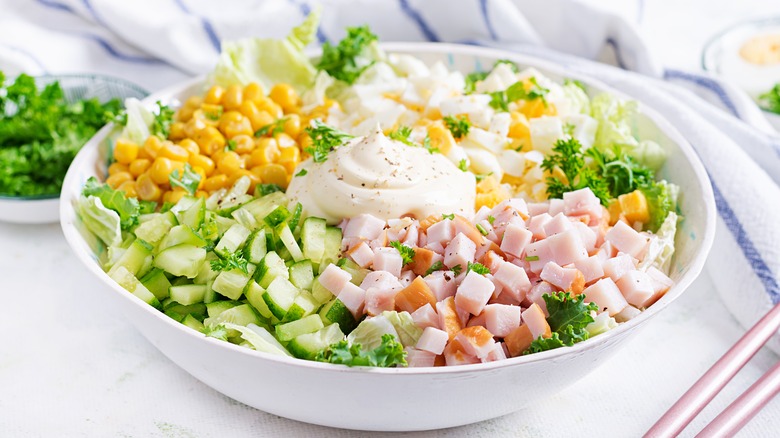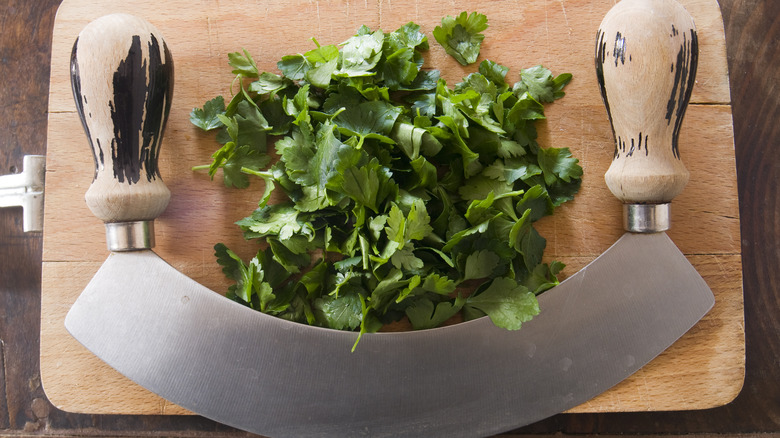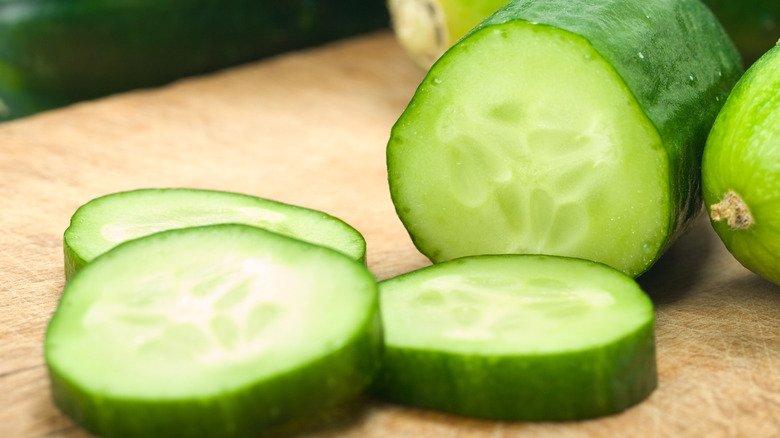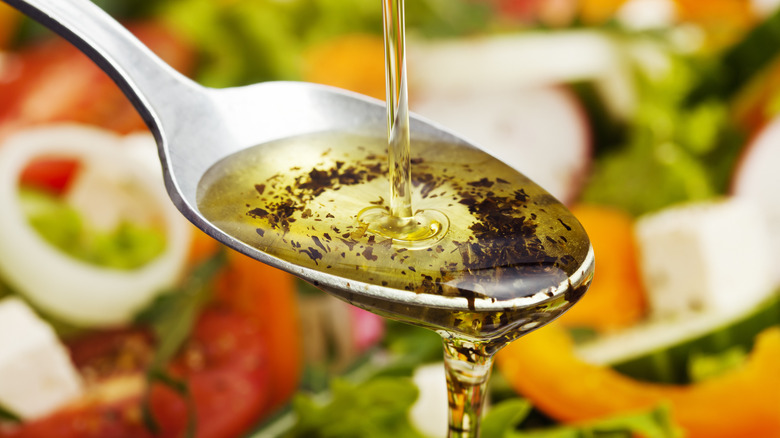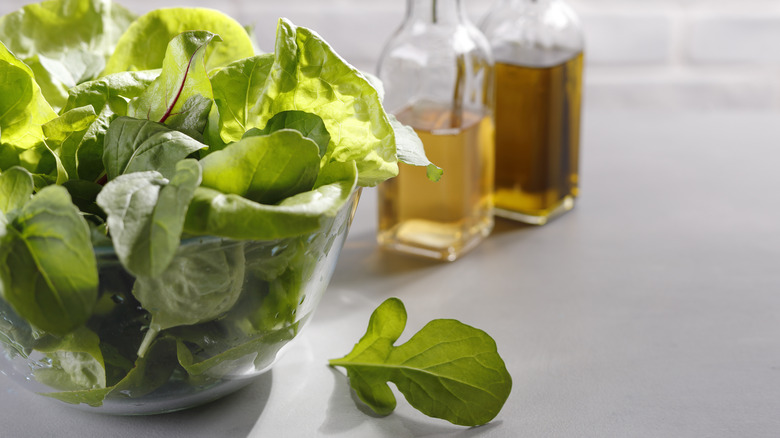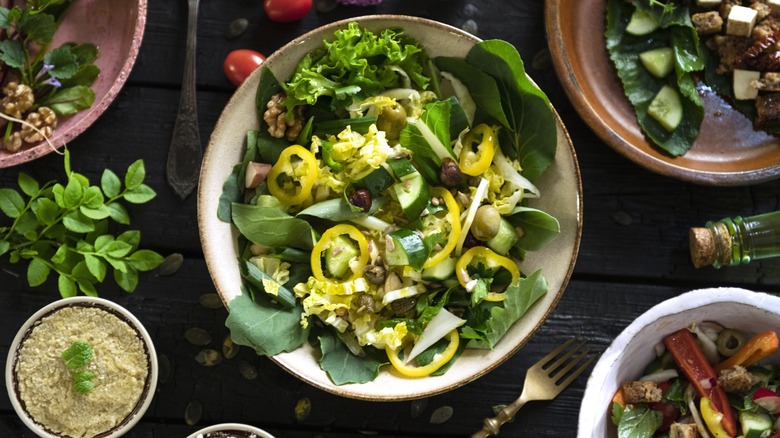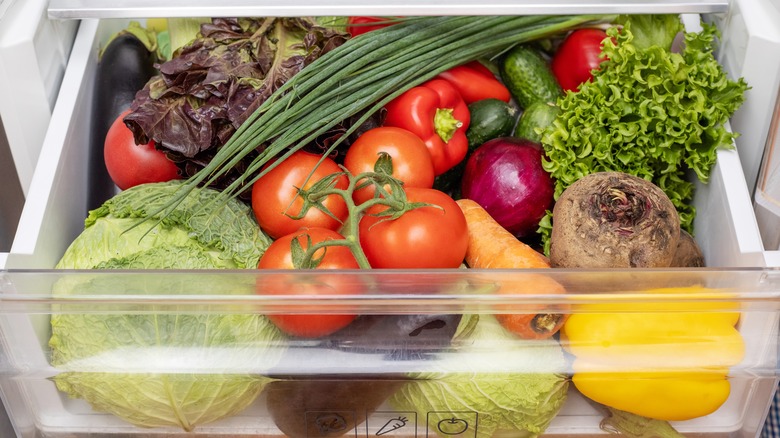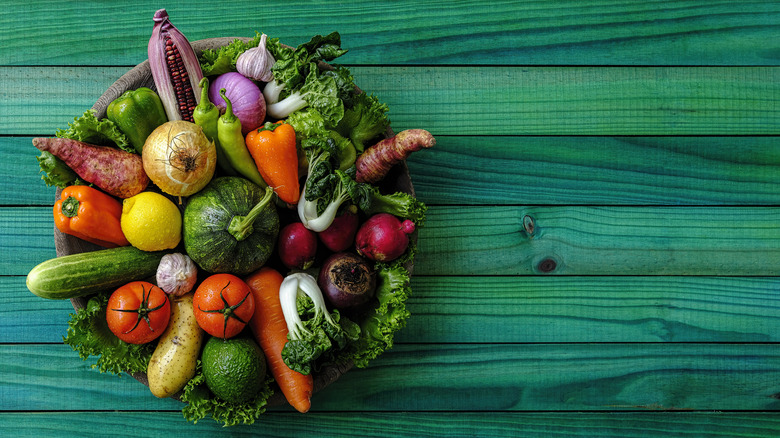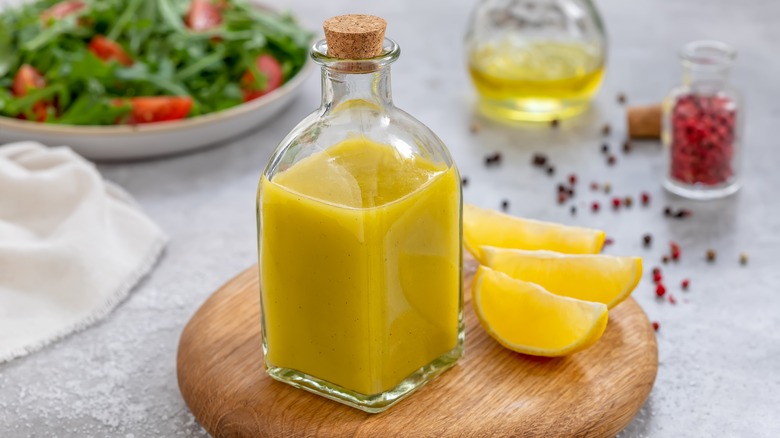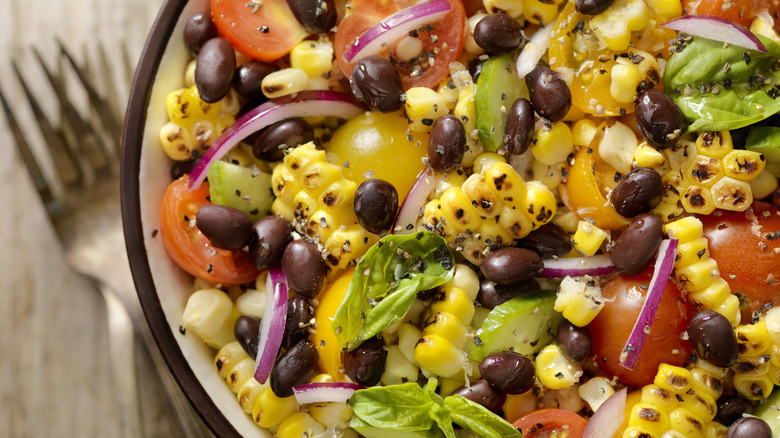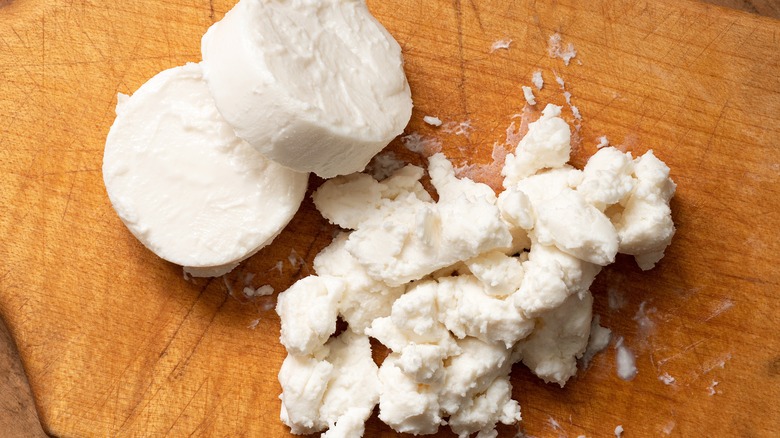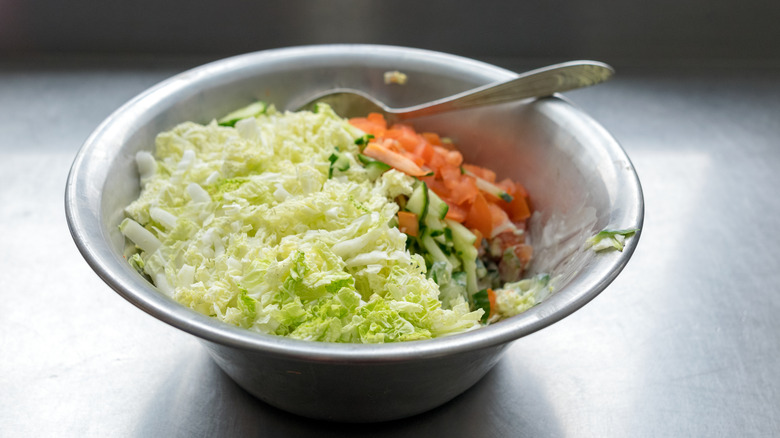13 Chopped Salad Mistakes You're Probably Making
The chopped salad is a meal that only seems to get more popular as time goes on. While the process of chopping vegetables and throwing them together has been around since ancient Greek and Roman times, the "chopped salad" is a relatively recent phenomenon.
Chopped salads are defined by all of the ingredients being, yes, chopped into very small pieces and mixed together, but also by their ability to be customized to the whims of the diner. "It's about control, especially for millennials," Darren Tristano, a food service expert, told The New York Times. "They want the ability to customize and control what's happening to the food that's being prepared. They want it the way they want it."
A chopped salad can consist of pretty much anything you want, allowing you to mix up your favorite things into bites and then spoon them into your mouth in one go. While they first started appearing everywhere during the first few decades of the 21st century, they've recently seen a new surge of popularity thanks to TikTok catching on to how delicious they are.
Contrary to popular belief, a chopped salad isn't as simple as just chopping up a few things and hoping for the best. Making a proper chopped salad is an art, and getting it wrong is incredibly easy — and there are many mistakes you should steer clear of.
1. Not using a big enough knife
Chopped salad arguably relies on one thing more than anything else: The tool you use to cut it. If you use a tool that's too small, you'll face problems. This will take more time than using a big one. Using a small knife also relies on you having to maneuver your vegetables in a rather fiddly fashion. Using smaller knives to make your chopped salad can cause you issues with trying to get your ingredients to a uniform size. A larger tool and a solid technique will have you producing perfectly sized pieces quickly.
The best tool to use, though, is not actually a large one-handled knife, but a mezzaluna. This blade (the name of which translates to "half-moon" in Italian) is curved with a handle on each side and cuts items using a rocking motion. It helps you to cut not only with speed, but with precision.
"If you're cutting something with a mezzaluna, you can see exactly what size your ingredients are on the board so you can make sure you've cut down all the giant pieces but also haven't pulverized your greens," Ali Banks, Chopt Creative Salad Company's vice president of culinary, told Food & Wine. You shouldn't underestimate the fun factor of using a mezzaluna: It's far more enjoyable than cutting with a regular knife.
2. Including too many wet ingredients
One of the joys of a chopped salad is its combination of textures and flavors, all tied together by a well-made dressing. But you need to be seriously careful about the ingredients you're including. Adding too many wet ingredients — or vegetables that have a tendency to release moisture, like cucumbers or tomatoes — can cater down your salad significantly, diluting your dressing and making the whole thing sloppy. These vegetables also have a tendency to release water as they're chopped, turning into mush, and introducing an unpleasant mouth feel into the meal.
You can avoid this in several ways, and the first one is all about the timing. Softer vegetables that are more prone to being pulverized can be sliced separately and mixed into the salad at the very end — ideally just before you add the dressing and serve it so that the salt in the dressing doesn't sap any moisture out.
It can also help to deseed moisture-heavy vegetables like cucumbers and tomatoes to make the best chopped salad. Cucumbers can be easily deseeded by running a spoon down their interior and scooping the seeds out. Tomatoes can also sometimes be deseeded with a small spoon, although you might have more luck cutting them out with a sharp knife. Make sure you blot your vegetables after you deseed them, to get rid of any additional moisture.
3. Dressing it at the wrong time
A chopped salad is tied together by its dressing, which lifts each of your individual elements by giving them a kick of flavor. But exactly when you add your dressing will make a huge difference. If you add a dressing too soon before eating it, it can soften vegetables considerably. It mainly does so through the dressing's salt content, which saps any excess moisture out of the plants. This moisture then ends up watering down your dressing and leaves your chopped salad overly moist.
Importantly, though, this doesn't happen all the time. If your chopped salad consists primarily of dry and hard vegetables, it could benefit from spending some time with your dressing before you serve it, to allow flavor to permeate into the dish more effectively. Generally, though, it's usually best to leave it until just before you serve a chopped salad to mix the dressing in. Pour it in and stir a few minutes before eating, ensuring that it's well-mixed so that every part of your salad is coated. If you're preparing the salad in advance, you can prepare the dressing too — just do so in a separate bottle, and keep it away from your vegetables until you're ready to eat.
4. Using leaves in your salad
Greens like lettuce, spinach, and kale are an essential part of many salads. But when it comes to chopped salad, using leaves can lead to trouble. Interestingly, this isn't because salad leaves like lettuce bruise when you cut them, which is a common misconception. Lettuce and other leaves will turn brown at the same rate, whether they're sliced or torn. Instead, it's mainly due to the fact that salad leaves are way more tender than other vegetables. As a result, when you chop them using the hardcore action that a chopped salad requires, you end up breaking them down, turning them into pulp, and removing all of their crispness.
Rather than have this happen, we'd recommend you use robust, hardy ingredients in your chopped salad, first and foremost. Vegetables like carrots, deseeded cucumbers, bell peppers, and onions are all great choices that hold up to a mezzaluna's constant chopping. If you're really craving leaves in your salad, it might be worth chopping them separately and mixing them with the other ingredients at the end. Make sure to dry them thoroughly in a salad spinner after washing them, too, so they don't bring any annoying excess water into the salad.
5. Overloading your salad with ingredients
A chopped salad, when done right, can be a fiesta of colors, flavors, and consistencies. But it's all too easy to go too far with things. Adding too many ingredients into a chopped salad, while tempting, can ruin the taste of your meal. You may end up filling it with a load of contrasting flavors and textures that fundamentally don't go together and prevent it from tasting coherently. As well as this, you make a tremendous amount of work for yourself. More ingredients mean more chopping, more vessels to store ingredients in, and potentially more food waste.
To avoid this, keep things simple, and don't go overboard. "About five ingredients is kind of a sweet spot," Just Salad's Founder and Managing Partner Nick Kenner told First We Feast. Focus on getting good-quality ingredients that complement each other, while being different enough to hold their own. A good example is combining vegetables like cucumbers, peppers, and red onion. Each has a different color, creating visual appeal, but their unifying crunch factor means one won't stand out or be distracting.
6. Messing up your mix
How you mix a chopped salad will make a big difference to how it eventually turns out. Interestingly, to get the best chopped salad, you should mix it before you fully chop it. Why? Well, if you chop all of your pieces separately and place them together, you run the risk that you've cut something way too small. While this isn't the end of the world, it can ruin the uniformity of the salad and can mean that certain pieces of food aren't incorporated properly.
Start by grabbing a large mixing bowl, and placing all of the ingredients you want to use in there. Make sure you chop them roughly before you do this — you don't want to do all the work just yet, but placing whole fruit or vegetables in there will do you no favors. Placing your ingredients in a bowl first will also let you measure them out, so you're not making too much unintentionally.
Mix the ingredients roughly, and then dump them all out onto your chopping board. Then, use your mezzaluna to chop them down to your desired consistency. Return them to your bowl once you've done this, and mix them again. If needs be, you can then repeat the chopping process, to make things smaller.
7. Forgetting to clear out your fridge
In the United States, almost 60 million tons of food is thrown away each year, equivalent to roughly 325 pounds per person, according to Recycle Track Systems. While it's likely safe to say that the majority of people aren't throwing away that amount individually, it highlights the importance of using up what you have in the fridge.
Chopped salads present the perfect opportunity to do this. This meal is a perfect vehicle for any excess food you have. While we generally think of chopped salads as being full of raw, fresh ingredients, the truth is that you can put pretty much anything in them. Cooked meat, grilled or roasted vegetables, cheese, old peanuts, that half-can of chickpeas you haven't used up yet — anything can be thrown into a chopped salad, dressed, and enjoyed.
Just remember that, while you can use chopped salads as a way to reduce food waste, you don't want to do so at the expense of how it tastes. Make sure to keep your ingredients in some kind of order, avoiding random combinations that just won't go together.
8. Not including a protein
A chopped salad can be incredibly satisfying, but only if you have the right ingredients. Including protein, fat, and fiber in a salad is a surefire way to make it filling, thanks to each of the separate components' abilities to reduce appetite. But while you may have fiber covered by your vegetables, and fat covered by your dressing, protein can often be missed out, leaving you with an underpowered meal.
Ensure that you're putting a protein source in your chopped salad. Beans and pulses like chickpeas, black beans, or cooked lentils can be a fantastic option. They're high in both protein and fiber and as they're already in bite-size pieces, you don't even have to chop them. Just stir them through the rest of your chopped ingredients at the end.
If you eat meat, chicken or turkey breast are always great choices for protein in a salad, thanks to their mild flavor and easily-choppable shape. Hard-boiled eggs or hard cheeses like cheddar or halloumi can also be easy additions, and can be chopped up with ease — and they also deliver some satiating fats.
9. Forgetting about contrast
While too much contrast in a chopped salad can be distracting and needless, not having enough — or any at all — is a surefire way to make your meal boring. Textural contrast, in particular, was found to be a universally appealing trait in food across multiple food cultures, according to a study published in the Journal of Texture Studies. Flavor contrast is just as important, with different tastes, like saltiness, sweetness, and umami, all working to boost each other and make a dish better.
Try to include different elements that will offset each other in exciting, complementary ways. If your salad is made up of mainly savory ingredients, try adding apples or grapes into the mix. If the palette of your salad is particularly sharp or vinegary, you could add in a creamier element, like a mild cheese or avocado. If everything in your salad is hard and crunchy, experiment with including some softer components, like some cooked, cubed sweet potato, squash, or chunks of bright purple cooked eggplant. The last option is also a great way to add some color contrast to your salad, which is another big factor in how appetizing it looks.
10. Making an unbalanced dressing
While the individual tastes in your chopped salad will each give something to the end dish, nothing lifts its flavor like a good dressing. But while the optimal salad dressing is bright, vibrant, and boldly flavored, it can quickly become unwieldy. Making a good dressing requires just the right balance of a few pretty strong flavor components, like salt and acid, and if you get the balance wrong, your whole salad will taste terrible.
If you're making a dressing, the main rule of thumb is to taste as you go. Frequent tastes of your salad dressing will allow you to figure out what it needs more of, or conversely, what you've added way too much of. If your dressing is overly acidic or salty, the easiest way to solve this is by adding more of the other ingredients to balance it again.
Importantly, the best salad dressings contain many of the five main tastes (sweet, salty, sour, bitter, and umami). If you miss any one of these, your dressing will never taste its best. Parmesan and Worcestershire sauce are good ways to cover the umami base, which can be one of the more challenging flavor elements to hit. Vegan-certified soy sauce is a good ingredient for people following a plant-based diet.
11. Not thinking about your salad's theme
The finest chopped salads are like a well-composed music score, where every instrument works together. If you have a dud note in there, though, the whole song is ruined. To bring it back to chopped salads, having a flavor that seriously doesn't work, or is from an entirely different world cuisine, will just be off-putting, and stop you from enjoying the other tastes in the meal.
To avoid this, you have to "theme out every salad," Just Salad's Founder and Managing Partner Nick Kenner told First We Feast. Think about what kind of essence you're trying to capture with your salad, and use ingredients that champion it, avoiding any out-there flavors.
Want something autumnal? Go for cooked pumpkin or sweet potato, combined with some seeds, soft cheese, some crumbled crackers, and apples or pomegranates. Or, put together a summer-themed salad, with chopped mango, grilled green beans, cucumber, and mozzarella. You could even put together a chopped salad with a Tex-Mex theme, by throwing in grilled corn, spiced beef or chicken, and black beans, with some cucumber, tomato, and avocado for good measure.
12. Chopping absolutely everything
Sometimes, the best chopped salads aren't fully chopped. While it's pretty satisfying to have everything sliced to the perfect size, some items just aren't suited for being chopped with a mezzaluna. Items like beans and chickpeas will get mushy fast when you start chopping them with other ingredients, and soft cheeses like feta or gorgonzola will quickly turn into a paste. Other items, like seeds or particularly hard nuts, won't fare well under the knife. Additionally, they don't really need to be cut at all, because of their small size.
So, make sure to keep your delicate or hard items off the chopping board. Soft cheeses can be sliced separately, but it's probably easier to just crumble them over the top, before stirring them in or leaving them as is as a garnish. You can scatter seeds over the top, too. Particularly small pieces of fruit, like pomegranate seeds, should also be scattered, as should herbs like parsley or coriander.
Bear in mind, too, that some types of fruit, like dried figs or dates, may be delicious in your salad, but can become very sticky when chopped, making your other ingredients clump together. These types of items are likely best chopped separately and used as a salad topper.
13. Storing your salad incorrectly
If you've made a chopped salad in advance, you want to make sure that it's fresh and crisp when you're ready to eat. But all too often, once your salad pieces are sitting together, some of them can start to wilt and soften, releasing water. This moisture can then seep into the other pieces of your salad, making the whole thing soggy – and that's all before you even add the dressing.
A workaround for this is an easy hack involving your bowl, some plastic wrap, and some paper towels. Place the paper towel over your salad ingredients in its bowl, and then cover the whole thing with your plastic, sealing it tightly. Then, turn the bowl over, and allow the vegetables to sit on the paper towel in your fridge. This will catch any moisture that leeches from the vegetables as it sits and will stop any wilting from occurring. Once you're ready to eat, turn it all back over, remove the wrap and paper towel, and then dress your salad as you normally would.
